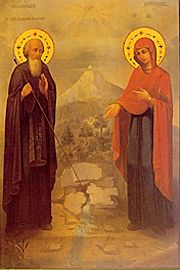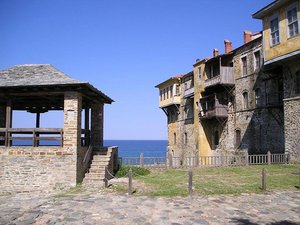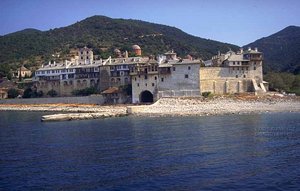Mount Athos
Mount Athos is a mountain and a peninsula in Macedonia, northern Greece, called Άγιο Όρος (Ayio Oros or "Holy Mountain") in Modern Greek, or Ἅγιον Ὄρος (Hagion Oros) in Classical Greek. It is home to 20 Orthodox monasteries and forms an autonomous state under Greek sovereignty. Only monks are allowed to live on Athos and the current population numbers around 1,400. The peninsula, the easternmost "leg" of the larger Chalkidiki peninsula, protrudes into the Aegean Sea for some 60 km at a width between 7 to 12 km and covers an area of about 390 km², with the actual mountain and its steep, densely forested slopes reaching up to 2,033 m.
The seas around the end of the peninsula can be dangerous. Xerxes I had a channel excavated across the isthmus to allow the passage of his invasion fleet in 483 BC.
Monastics from Mount Athos are often referred to as Athonites or Hagiorites.
Contents
History

Mount Athos as a monastic community was formally founded in 963, when St. Athanasius (not to be confused with the 4th century St. Athanasius the Great) established the monastery of Great Lavra, still the largest and most prominent of the 20 monasteries. It enjoyed the protection of the emperors of the Eastern Roman Empire during the following centuries and its wealth and possessions grew considerably. The Fourth Crusade in the 13th century brought new Roman Catholic overlords which forced the monks to seek protection from Pope Innocent III, until the restoration of the Byzantine Empire. It was raided by Catalan mercenaries in the 14th century, a century that also saw the theological conflict over the hesychasm practised on Mount Athos and defended by Gregory Palamas.
The Byzantine Empire collapsed in the 15th century and the newly established Islamic Ottoman Empire took over. They heavily taxed the monasteries, but for the most part left them alone. The population of monks and their wealth declined over the next centuries, but was revitalised around the 19th century by the donations and new arrivals from other Orthodox countries, such as Russia, Bulgaria, Romania and Serbia, while each country came to exert its influence on individual monasteries. In 1912, during the First Balkan War, the Ottomans were forced out and after a brief conflict between Greece and Russia over sovereignty, the peninsula formally came under Greek sovereignty after World War I.
Politically the peninsula is mostly self-governed and consists of 20 main monasteries and the capital city and administrative centre, Karyes, also home to a governor as the representative of the Greek state. Beyond the monasteries there are 12 sketae, smaller communities of monks, as well as many (solitary) hermitages throughout the peninsula. Visits to the peninsula are possible for laymen, but they need special permission.
Women are completely barred from the peninsula, a fact which has earned a certain amount of fame; even female domestic animals (with the exception, some say, of cats, as well as chickens which lay eggs that provide the fresh egg yolk needed for the paint used in iconography) are forbidden. However, during the Greek Civil War, Athos did shelter refugees including women and girls. [1]
In modern times, the Mount Athos monasteries have repeatedly been struck by wildfires, e.g. in August 1990, and in March 2004, fire gutted a large section of the Serbian monastery, Chilandari. Due to the secluded locations of the monasteries, often atop small hills, as well as the unavailability of suitable fire fighting gear, the damages inflicted by these fires are often considerable.
Languages
Greek is commonly used in all Greek monasteries, but in some monasteries there are other languages in use, in St. Panteleimon, Russian; in Chilandari, Serbian; in Zographou, Bulgarian; and in the sketae of Prodromou and Lacu, Romanian. Today, many of the Greek monks can also understand English or other European languages.
Pilgrims Info
Mount Athos, known in Greece as the Holy Mountain, is a peninsula in Halkidiki, north Greece containing 20 monasteries. Although the peninsula of Mount Athos is part of Greece, it enjoys certain autonomy. The region is governed by the "Holy community" under the ecumenical Patriarch of Constantinople. Only men are permitted to enter Mount Athos. The rule, known as the "ABATON", forbids access to Mount Athos by any female and is enforced by law. In accordance with the procedures established by the Holy Community foreigners must obtain a written permit to visit Mount Athos from the "Mount Athos Office"(Γραφείο Προσκυνητών Αγίου Όρους). Pilgrims who arrange their reservations by phone should mail a copy of their passport to the office, and call two weeks before the date of the visit to confirm the reservation. The Mount Athos Office is open: from Monday to Saturday from 09:00 to 13:00. The address is: 109 Str. Av. Egnatias – 54622 Thessalonica Greece. Tel.:0030-2310-252578 and fax: 0030-2310-222424. Generally, the office issues only 10 permits per day for foreigner pilgrims and 110 for Greek orthodox pilgrims. Because of the small number of permits my advice is to contact the office well in advance. These permits are valid for a 4days stay in Mount Athos. Permits are issued to adult male pilgrims over the age of 18. Young males under 18 are permitted if they are accompanied by their father. Young men who are accompanied by an adult group leader visiting Mount Athos for educational reasons need the written consent of their parents, verified by an official authority of their country. Pilgrims can go to Ouranoupolis by car or by bus. It is about 120km from the airport of Thessalonica. When pilgrims arrive in Ouranoupolis, the port where ferryboat depart to Mount Athos, must go to the "Mount Athos office for pilgrims" and take the diamonitirion (visitors permit). The pilgrim’s office is open every day including Saturdays and Sundays from 07:30. This permit is required upon boarding the ferryboat and also when pilgrims arrive at the monasteries. It costs €35. Students pay €18. The ferryboat leaves at 09:45 from Ouranoupolis. We recommend to pilgrims to arrive in Ouranoupolis one day earlier if it possible. This ferryboat arrives in Mount Athos port of Dafni around 12:00. From Dafni you can take the bus to Karyes the capital of Mount Athos and from there to other monasteries. Pilgrims can move to Mount Athos with mini busses (mini bus tel.: 0030-23770-23266 and fax: 0030-23770-23879) There is also a ferryboat that departs from Ouranoupolis port at 06:30 (ex. Sat/Sun-see Mount Athos ferry timetable) F.B. "Agia Anna". In this case the pilgrims must notify to Pilgrims Office before the arrival and obviously if they want to travel with the F.B. "Agia Anna". It is better to spend the previous night to Ouranoupolis. Pilgrims to Mount Athos should be decently dressed (no shorts pants). Several penalties are enforced against anyone who attempt to remove religious items from Mount Athos. The entrance of video cameras on Mount Athos is strictly forbidden.

List of Monasteries and Sketes
Categories > Images
Categories > OrthodoxWiki > Featured Articles
Categories > Places
Categories > Places > Monasteries
Categories > Places > Monasteries > Athonite Monasteries
Categories > Places > Orthodox UNESCO World Heritage Sites
Categories > Places > Pilgrimage Sites
Categories > Spirituality > Asceticism
Categories > Spirituality > Asceticism


